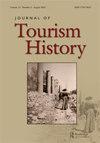How the New Deal built Florida tourism: the Civilian Conservation Corps and state parks
IF 0.9
Q4 HOSPITALITY, LEISURE, SPORT & TOURISM
引用次数: 0
Abstract
Europeans to come to Czechoslovakia in the early Cold War years, it was practically impossible for US citizens. Pedersen also deals with the individual stages of tourism development. He states that even as late as 1980, Western tourists perceived Eastern Europe as an unknown and almost exotic territory. Two more studies need to be mentioned to fully appreciate the weight of the whole publication. The first one is Michal Fejtl’s chapter, which fills the gap in the historiography regarding Czech and Slovak spa resorts. Although he concentrates on a case study of the spa town Mariánské Lázně in West Bohemia, his findings can be applied to most spa areas in the rest of the country. The author includes intriguing details about the stays of domestic and foreign visitors. Special attention is paid to the East and West Germans’ visits, and their mutual celebration of the fall of the Berlin Wall on 9 November 1989. The other study is Petra Schindler-Wisten’s chapter, which adds an essential element to the volume – the relatively widespread Czech phenomenon of cottages and weekend houses, which has retained its importance among the Czech population to the present. As the author states, some 12 percent of Czech households have a recreational property – one of the highest among European nations. The authors use very cultivated language, making the text convenient to read for both the academic community and the broader public. As part of the effort to offer a factually dense text, the authors, Mücke in particular, include period-style jokes and anecdotes in the text, but their randomness is sometimes disruptive. Quoted statements by narrators that are repeatedly used by other authors are appreciated as historical testimonies, but some of them are quite superfluous in the context of the narrative. Nevertheless, it is obvious that the reviewed publications fundamentally fill a gap in the research of Czech/Czechoslovak history after 1945. The results reveal knowledge about various forms of tourism, regulations, and management in the communist regime. It is necessary to appreciate the transmission of new information to the reader and the scientific verification of what was previously considered ‘common knowledge’, personal memories of older generations, or curiosities in popular articles. The authors transformed these into a comprehensive framework adding significant value to contemporary historiography.新政是如何建立佛罗里达旅游业的:平民保护队和州立公园
欧洲人在冷战初期来到捷克斯洛伐克,对美国公民来说几乎是不可能的。佩德森还研究了旅游业发展的各个阶段。他说,早在1980年,西方游客就认为东欧是一个未知的、几乎充满异国情调的地区。需要再提到两项研究,才能充分理解整个出版物的重要性。第一章是Michal Fejtl的章节,填补了捷克和斯洛伐克温泉度假村史学的空白。尽管他专注于对西波希米亚的温泉小镇MariánskéLáznŞ的案例研究,但他的发现可以应用于该国其他地区的大多数温泉地区。作者介绍了国内外游客逗留的有趣细节。人们特别关注东德和西德的访问,以及他们在1989年11月9日共同庆祝柏林墙倒塌。另一项研究是Petra Schindler Wisten的章节,该章节为该卷添加了一个重要元素——捷克相对普遍的小屋和周末别墅现象,至今在捷克人口中仍保持着重要地位。正如作者所说,大约12%的捷克家庭拥有娱乐场所,这在欧洲国家中是最高的。作者使用了非常有修养的语言,使文本便于学术界和广大公众阅读。作为提供事实密集文本的努力的一部分,作者,尤其是穆克,在文本中加入了时代风格的笑话和轶事,但它们的随机性有时会造成破坏。其他作者反复引用的叙述者的陈述被视为历史证词,但其中一些在叙事背景下是多余的。尽管如此,很明显,被审查的出版物从根本上填补了1945年后捷克/捷克斯洛伐克历史研究的空白。研究结果揭示了对共产党政权中各种形式的旅游、法规和管理的了解。有必要欣赏向读者传递新信息,以及对以前被认为是“常识”、老一辈的个人记忆或流行文章中的好奇心的科学验证。作者将其转化为一个全面的框架,为当代史学增添了重要价值。
本文章由计算机程序翻译,如有差异,请以英文原文为准。
求助全文
约1分钟内获得全文
求助全文
来源期刊

Journal of Tourism History
HOSPITALITY, LEISURE, SPORT & TOURISM-
CiteScore
0.60
自引率
0.00%
发文量
16
期刊介绍:
The Journal of Tourism History is the primary venue for peer-reviewed scholarship covering all aspects of the evolution of tourism from earliest times to the postwar world. Articles address all regions of the globe and often adopt interdisciplinary approaches for exploring the past. The Journal of Tourism History is particularly (though not exclusively) interested in promoting the study of areas and subjects underrepresented in current scholarship, work for example examining the history of tourism in Asia and Africa, as well as developments that took place before the nineteenth century. In addition to peer-reviewed articles, Journal of Tourism History also features short articles about particularly useful archival collections, book reviews, review essays, and round table discussions that explore developing areas of tourism scholarship. The Editorial Board hopes that these additions will prompt further exploration of issues such as the vectors along which tourism spread, the evolution of specific types of ‘niche’ tourism, and the intersections of tourism history with the environment, medicine, politics, and more.
 求助内容:
求助内容: 应助结果提醒方式:
应助结果提醒方式:


